Purchase Details: I bought the Yamaha Silent Bass SLB300 on September 28, 2024, at 1:14 p.m. from Kurosawa Violin in Tokyo. This instrument has not only impressed me with its quality and portability but has also transformed my lifestyle. I can now practice late at night with a sound remarkably close to that of a double bass. Before I forget, I’ll share my thoughts on the internet.
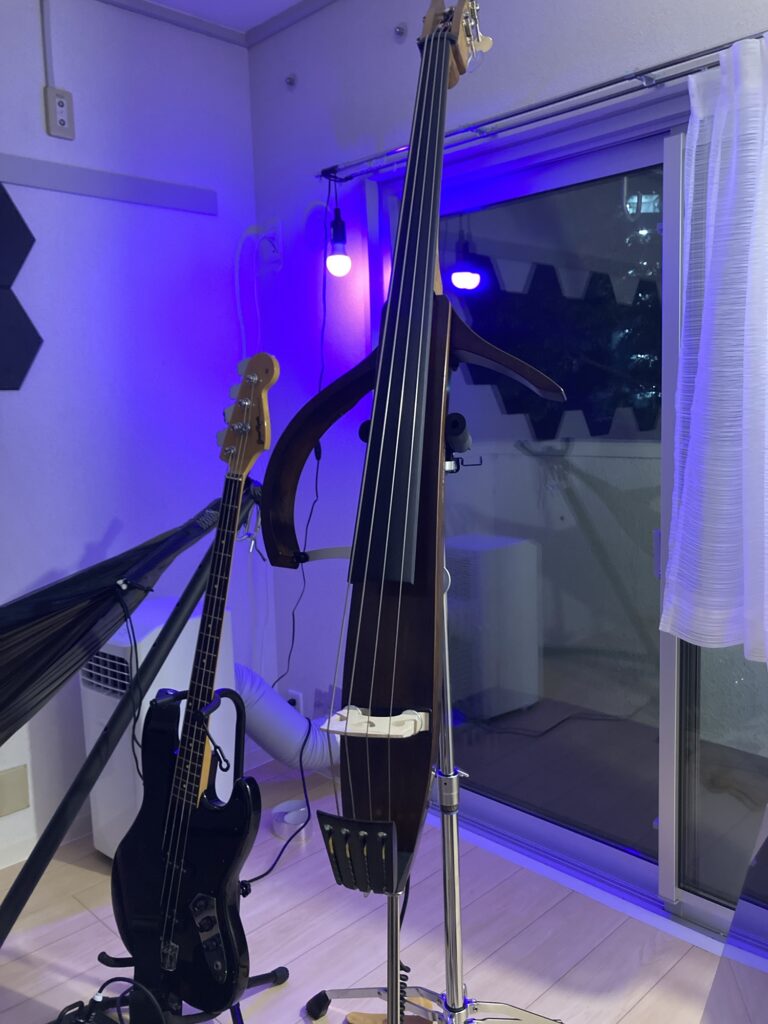
◯Appearance
It looks like an airplane. It is quite large if I use the stand together. It has a luxurious feel that is visually noticeable. There are differences in the grain of the wood in the details of the body, and you can feel the attention to detail of YAMAHA.
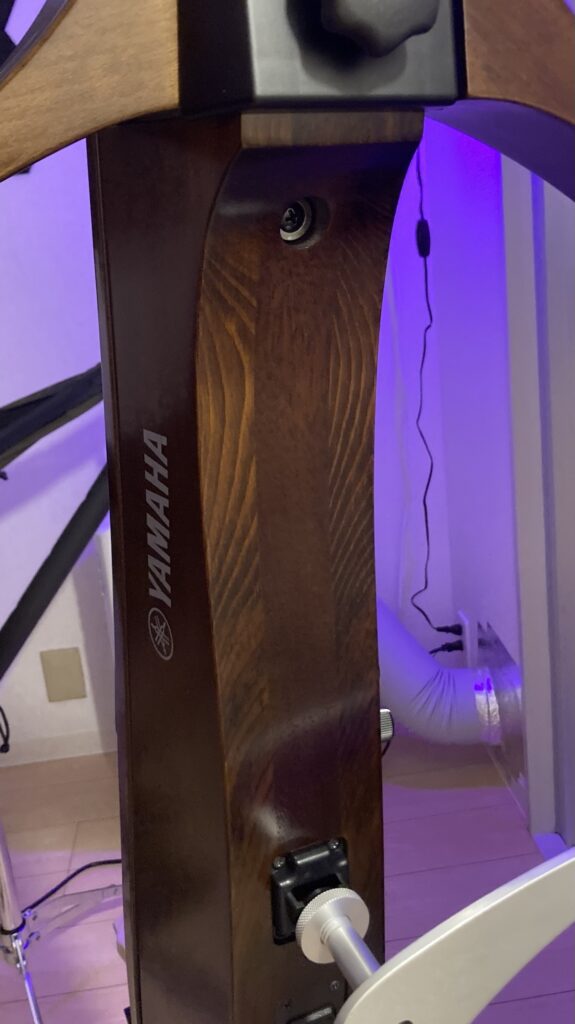
The pegs are sturdy and do not go out of tune. The material appears to be steel(?). The body is small and the pitch is not easily affected by temperature/humidity changes.
Postscript(10/20): Japan is currently experiencing temperature swings of over 10°C, and while the pitch of my SLB300 fluctuates(±20Hz), it’s not as unstable as my double bass.
Postscript (11/1): Strangely, after the initial adjustment period with temperature swings, my SLB300 has stayed in tune—even with over 10°C shifts. It seems that the instability was only an issue at the beginning of the season.
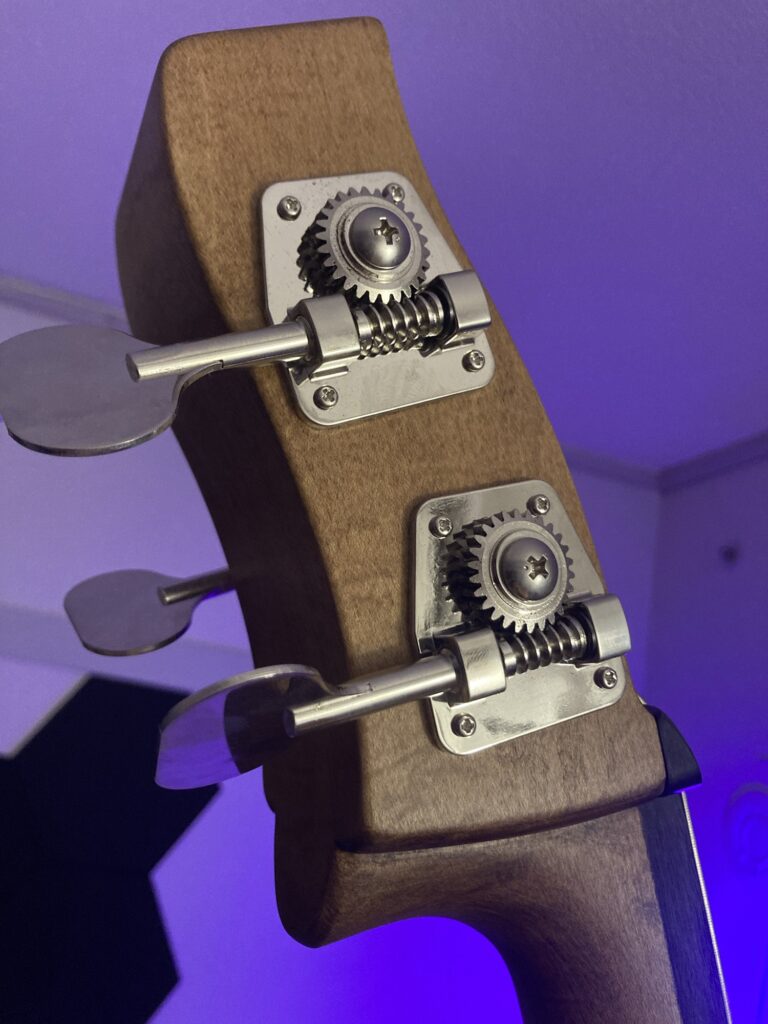
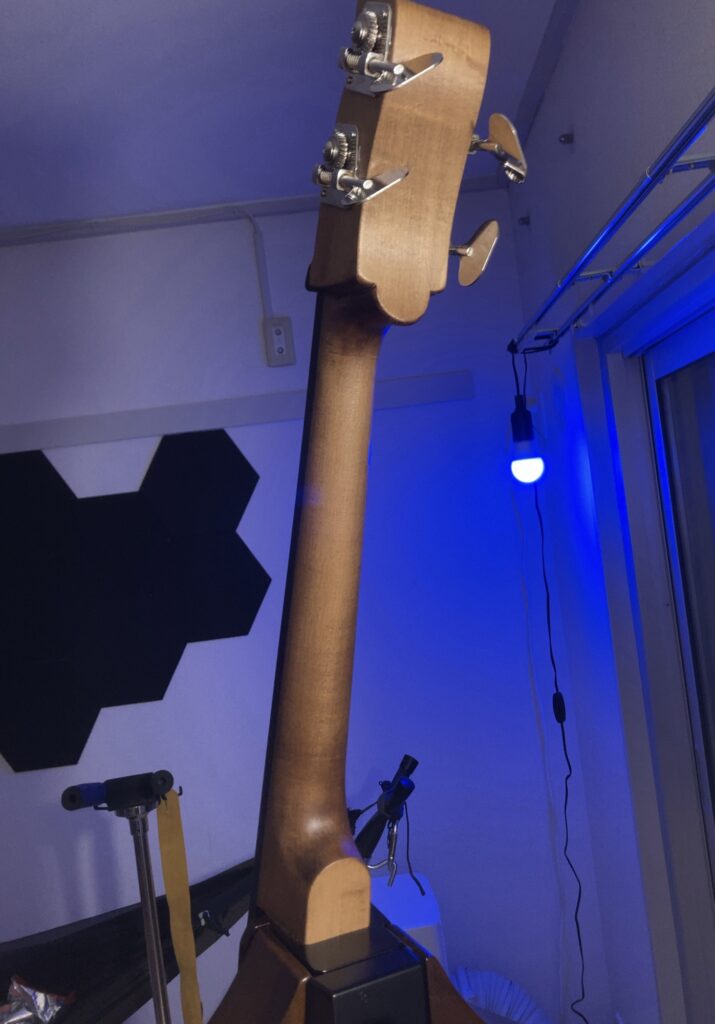
The neck has a subtle dark brown finish. It feels good to the touch.
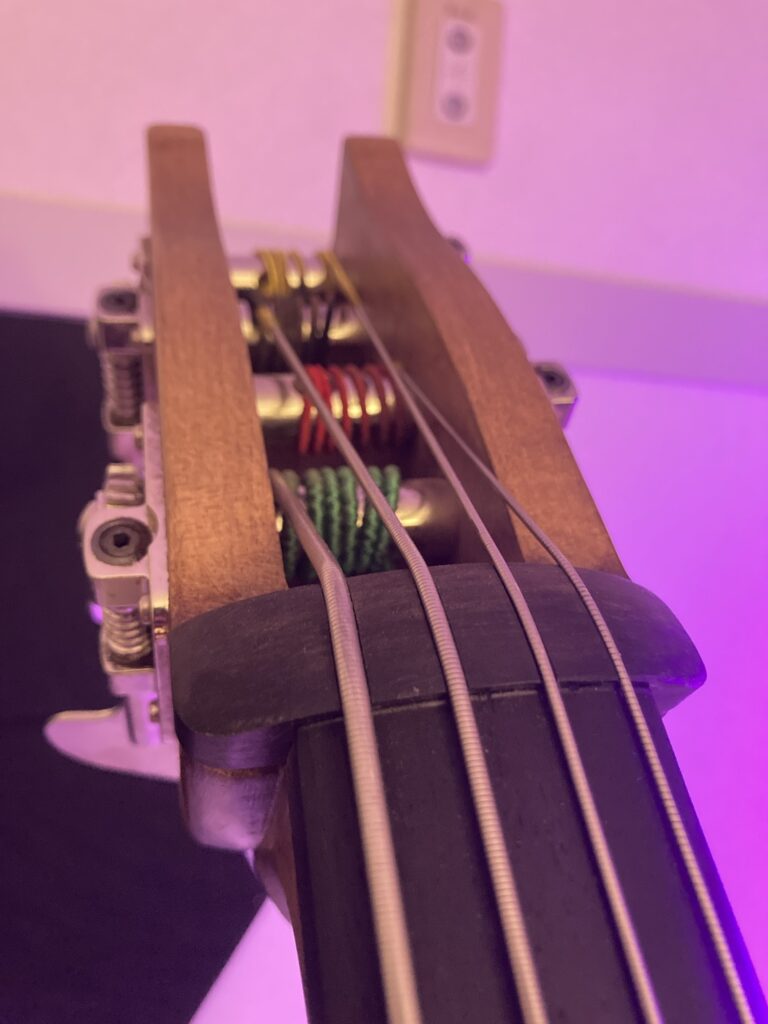
◯Material
The material used appears to be high in visual quality. When I actually touched it, I noticed that the fingerboard and neck wood are hard. Compared to the neck of hybrid veneer double bass I used to have in the U.S. and the neck of plywood bass I have now, it is the hardest to the touch and shows the high density of the wood. Similarly, the rosewood fingerboard is hard and has a deep black finish.
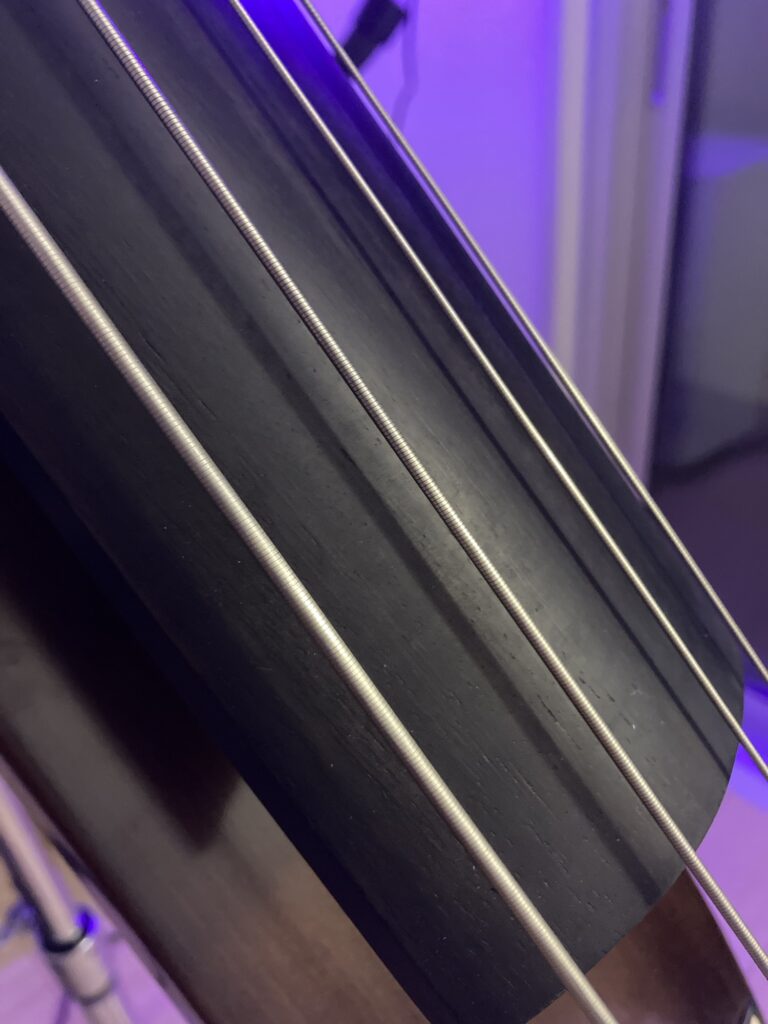
公式情報(材質)
Neck:Maple
Body:Spruce/Mahogany
Frame:Beech (Detachable)
Finger Board:Rosewood
Bridge:Maple (Height Adjustable)
Tailpiece:Ebony (Reverse Type)
—–
The SLB300PRO has a curly maple neck and ebony fingerboard, and weighs 200g more than the SL300. The bridge adjuster appears to be made of aluminum, although it is not listed in the catalog specs.
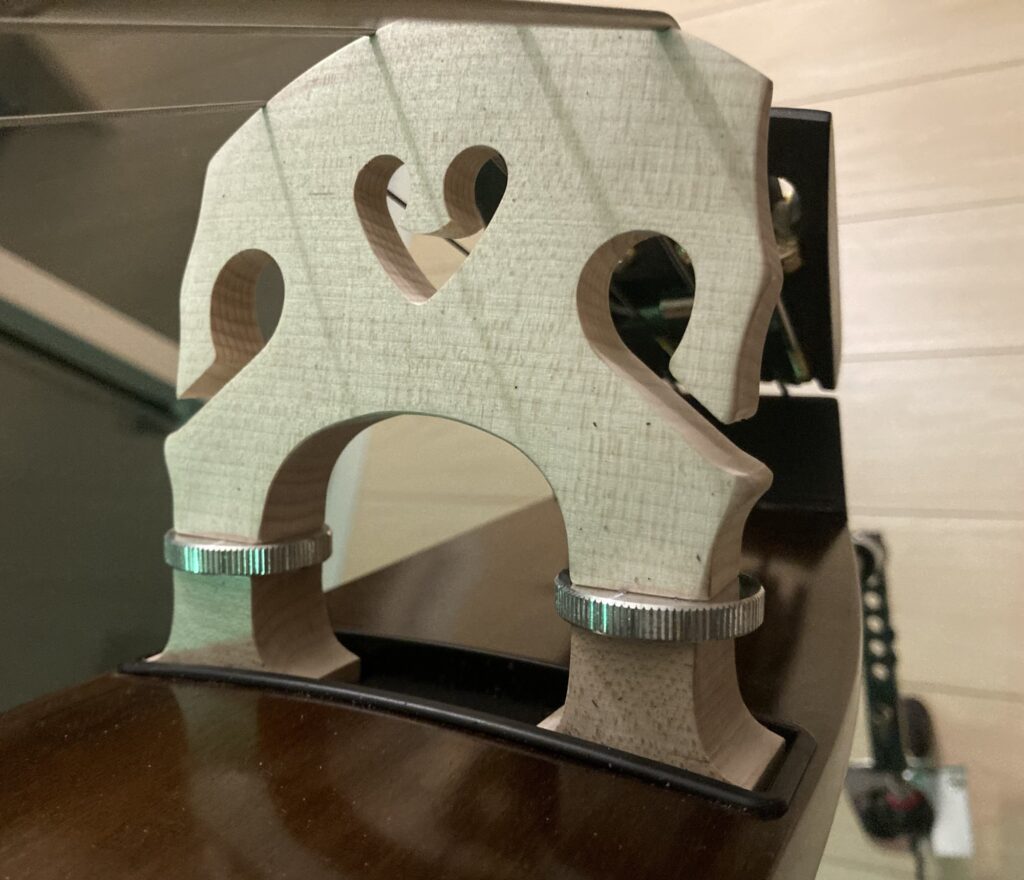
Aluminum adjusters specially selected for the SLB300PRO also provide a notable upgrade that allows the player to adjust string height.
Incidentally, the adjusters for the SLB300 PRO are made of aluminum, according to the official description. I am wondering if they settled on aluminum after trying various materials such as cold-rolled carbon steel and brass, etc. It would be great if YAMAHA would release sampled sound sources and experimental data.
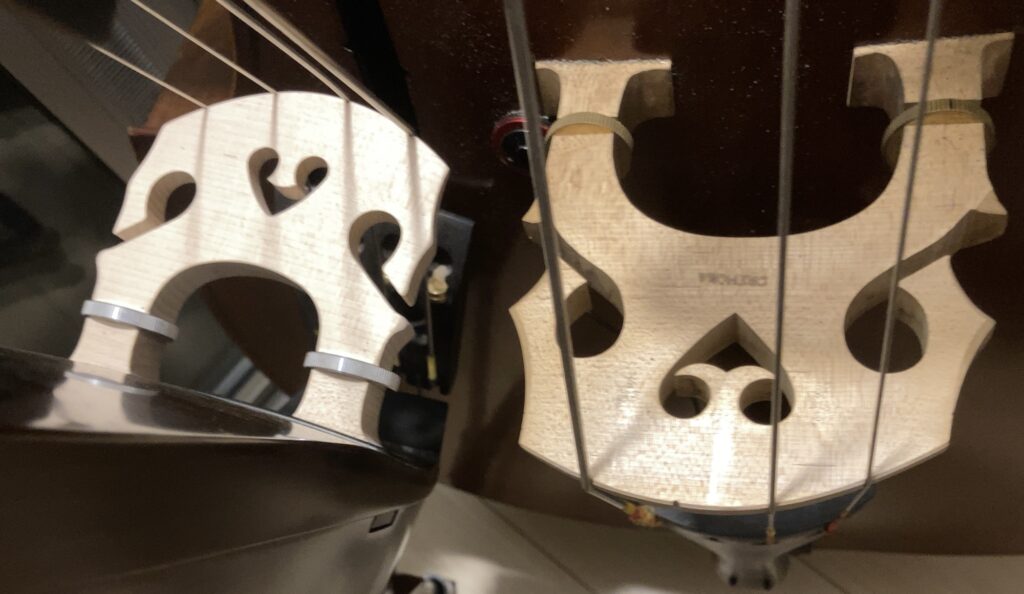
Around the endpin. The tailpiece is ebony and looks coarse-grained. The tailpiece of a double bass has a ball end that goes directly through the hole. On the other hand, SLB300(Reverse Type) is folded back and wrapped around the peg after passing the ball end through the hole.
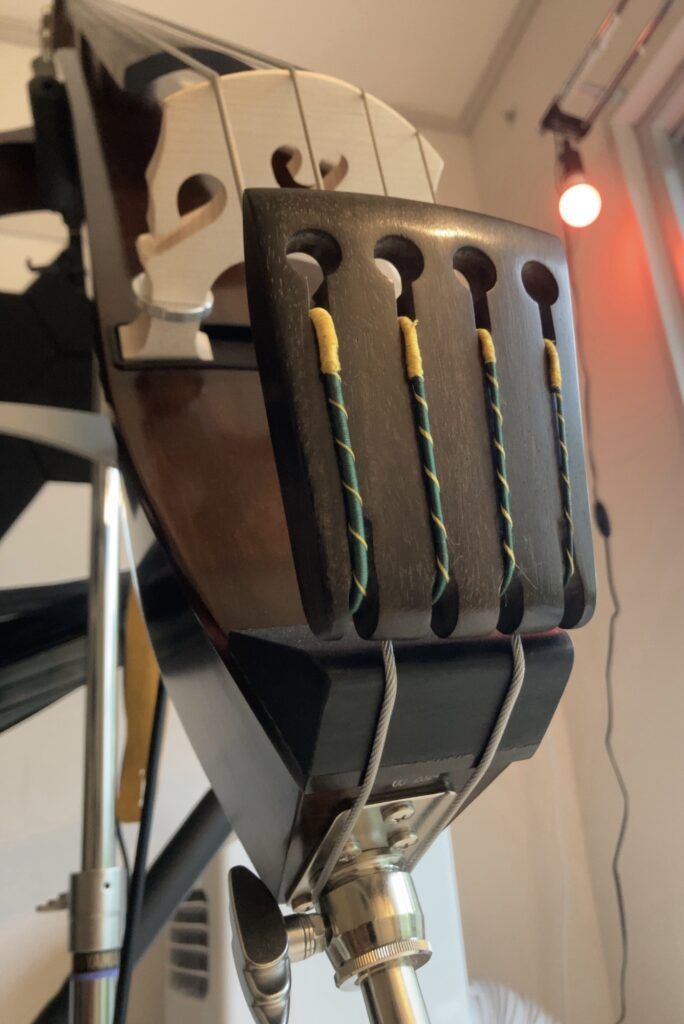
The end pin is made of 16mm stainless steel. It is thicker and stiffer inside than a pipe at a home improvement store. Compared to a double bass, it is necessary to extend the endpin considerably longer, so it makes sense that the SBL has a 16mm endpin made of stainless steel, as opposed to the common endpin (10mm).
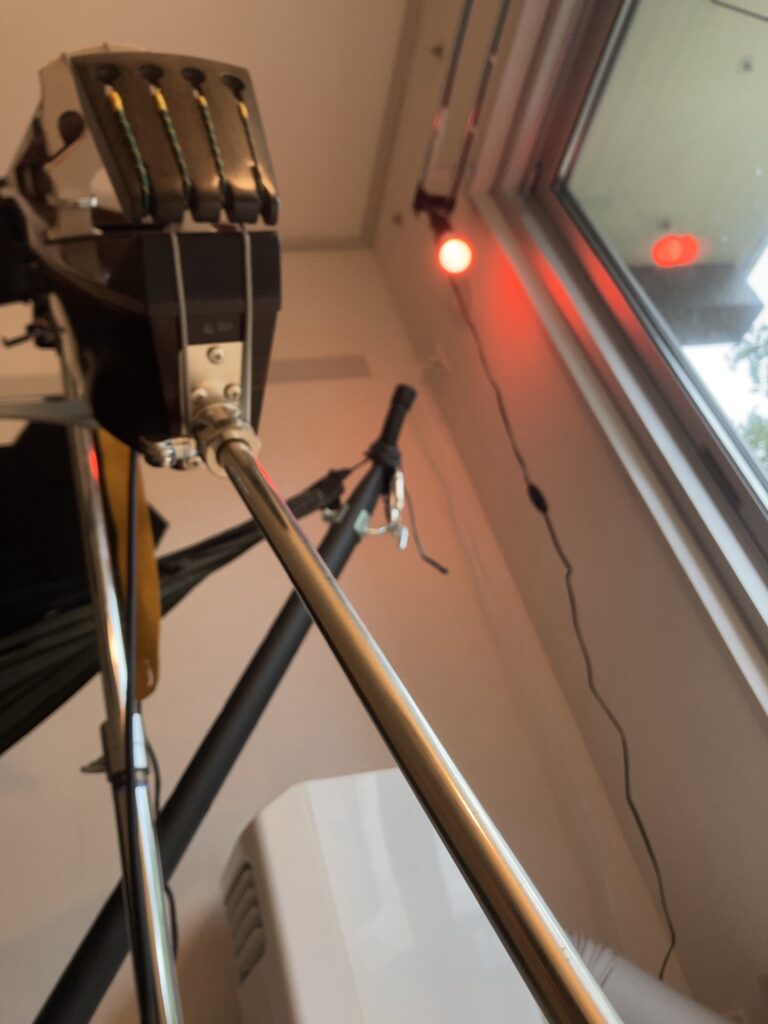
◯String height
| String | SLB300 | My Double Bass |
| G | 3.1mm | 4mm |
| D | 4mm | 5.2mm |
| A | 4.5mm | 6.3mm |
| E | 6.1mm | 7.1mm |
Although the string height is considerably lower than that of the plywood double bass, the sustain is greatly increased and the dead point, which was common on the plywood double bass, is not found so far. I would like to thank Kurosawa Violin for perfectly adjusting my SLB300, which is not a toy but a musical instrument itself, so it was the right decision to buy it after having it adjusted at a professional store instead of buying it used on the Internet. I asked Kurosawa to lower the string height as low as possible without buzzing when I played pizzicato hard, and they provided me with the exact setup I was looking for. The staff member who responded to my request was also a skilled jazz player, so he seemed to have knowledge about pizzicato dynamics and buzz. I was happy that Kurosawa was able to meet my pinpoint needs.
◯String Type
The strings are D’Addario Helicore Hybrid light gauge strings. The tension of this string is a little stronger than the “Pizzicato Light Gauge” of the same manufacturer. I like this tension as well. When playing pizzicato in jazz, it is easier to play strings with loose tension. On the other hand, if there is a certain amount of tension, the strings bounce back less immediately after being plucked, making it easier to play. I also believe that the string vibration width is suppressed and buzzing is less likely to occur. I have a D’Addario Pizzicato on hand, but the sound of the hybrid is so good that I was hesitant to go to the trouble of replacing the strings to test it. I put D’Addario Pizzicato strings on my SLB300, but the sustain of the sound decreased and it buzzed more easily, so I switched back to hybrid strings. I realized that the hybrid was suitable for my playing style and the current low action.
◯Impression and feeling
Good sound. Easy to play with low string height. The neck is slightly closer to a U-shape than my double bass. My double bass had the neck reshaped, so it is more like a V shape (this neck shape may just be unique). These were my first impressions within a few minutes of playing. Also, the joint between the neck and the body does not feel too thick, but some might want to shave it a little thinner; I see users on Talkbass.com who have shaved and reshaped their necks.
Incidentally, the tripod is wide enough to stand a double bass on.
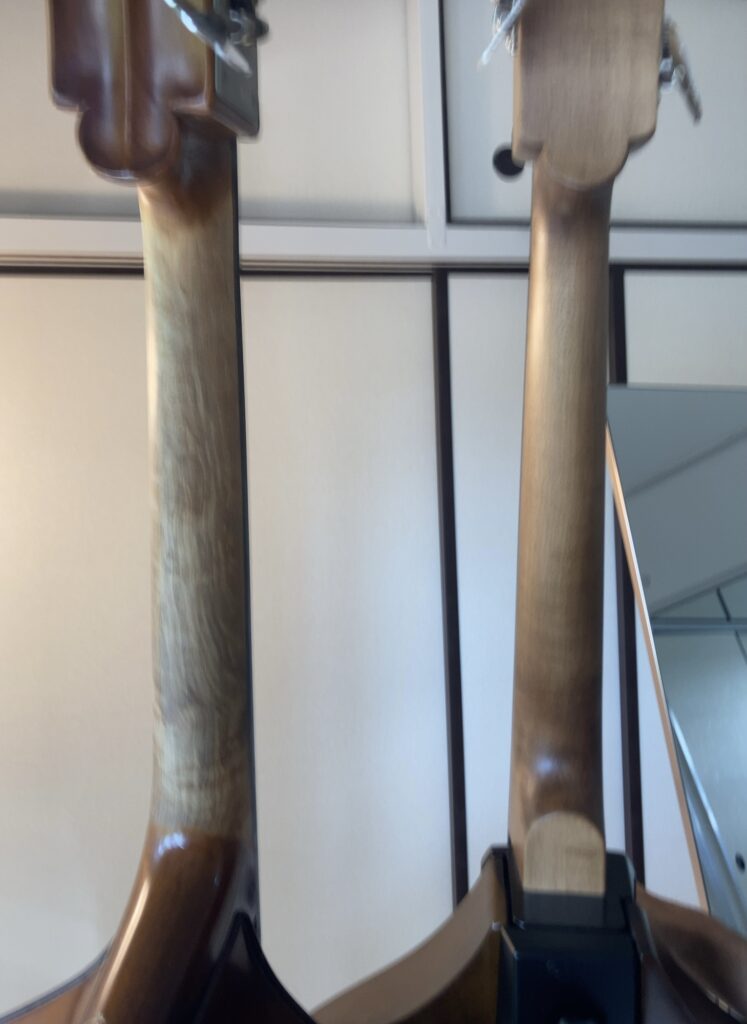
When it comes to a neck type(D or Eb), the neck is a D. I wasn’t asked about my preference when I purchased it from Kurosawa, so I assume D is the default.
Another thing I noticed was a strong chemical smell, likely from the black paint applied to the fingerboard by Kurosawa Violin. While it wasn’t unpleasant, it’s worth noting that this might be a specific issue with Kurosawa and not a general concern for SLB300 owners who purchased from other retailers.
◯Tone
The tone was like a huge fretless bass that is as close to a double bass as possible. The sustain in the high range was bright and long. However, this tone is wonderful. I can add microphone simulation and EQ (High/Low) by turning the power off and on. As I describe later, even with just the passive (power off) piezo pickups, the sound is good with clearly defined contours. The SLB300’s pickups themselves are already excellent, and they pick up a powerful sound without the “airiness” light characteristic of piezo pickups. On the other hand, unlike the PUs used in electric bass guitars, the SLB300 pickups do not have an electric tone. It is more like a KALA ukulele bass PU with added punchy, thumpy tone and clear definition. I think it is a strange PU in that it is unprecedented. The body of the instrument vibrates well even though the internal cavity volume is smaller than that of a contrabass. You can feel the vibration from the body through the frame, which is the contact point with the body. Even when playing high notes in the high position, the vibrations of the strings and fingerboard can be felt(neck vibrates too). The volume is not loud enough for an acoustic jam, but it can be practiced just barely without an amp. The volume is at a level where the tuner can just barely hear the notes. The SLB300 was 50-70 db, while the double bass was 70-80 db. The difference is significant because db is on a logarithmic scale.
One aspect that sets the SLB300 apart from a double bass is its unique tonal quality. When playing pizzicato notes above G in the third octave, I noticed a slight sharpness that reminded me of a steel pan.
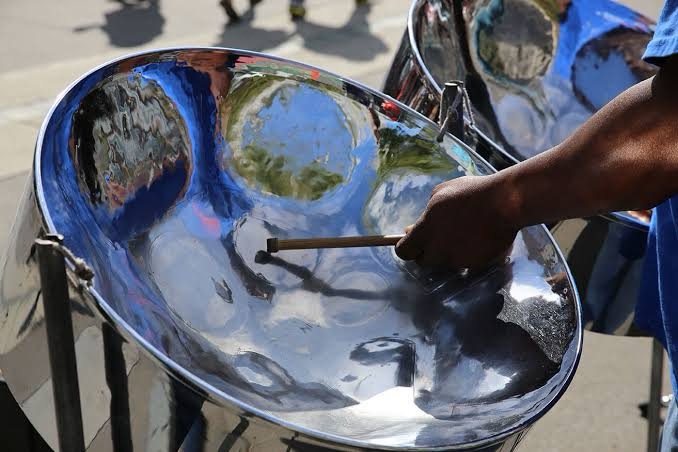
This is only a very slight difference in nuance, but I feel that this slightly audible bright tone is what separates it from the double bass tone. There is potential in this regard, as changing to darker sounding strings may bring it closer to a more organic sound.
◯ Electrical system
-EQ, control knob
The volume goes up when the power is switched from OFF to ON. And when turned on, in addition to the treble and bass of the EQ, the ratio of pickup (PU) ⇔ mic simulation (MIC) can be adjusted with the blend control knob. In addition, by pressing and holding this blend knob, you can switch between the three mic simulations.
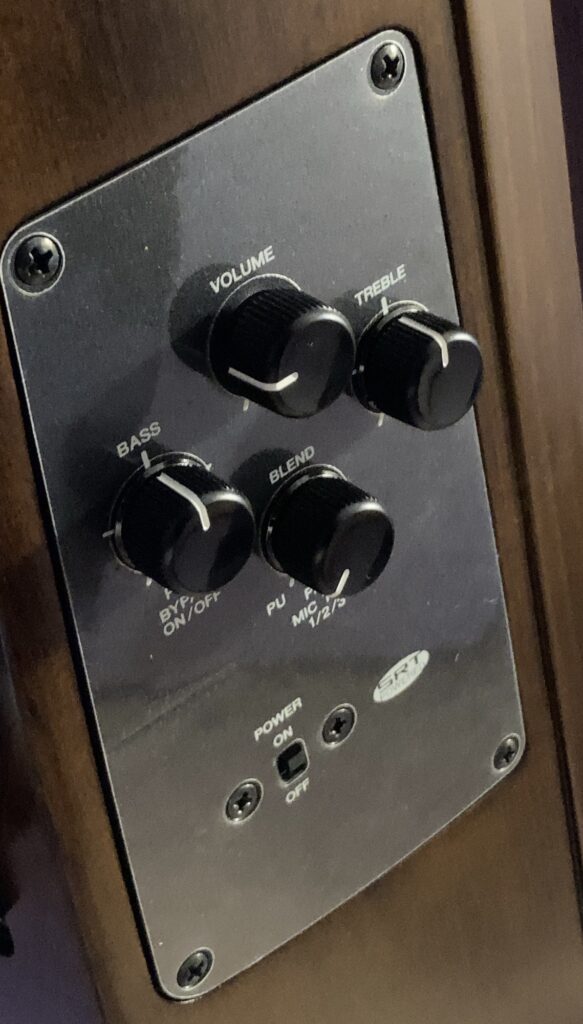
Mic 1 (Rich) – A highly valued vintage tube microphone that delivers smooth, well-balanced sound.
Mic 2 (Clean) – A dynamic microphone that is often used for its clear, well-defined sound.
Mic 3 (Warm) – With a different tube microphone character than Mic 1 (Rich), this classic microphone is known for a more emphasized low range and overall warmth.
Rich (1) has a good balance of sound range, Simple (2) has a stronger midrange, and cuts the most among the three. 3 has a more ‘air’ sound with less definition. My favorite is Simple 2, with a 90% PU/10% MIC ratio. After trying out various options, I found that the PU all the way up sounds the best when looking for a good ensemble output. However, since this would give the sound of a “fretless bass,” I added a little MIC to bring in some acoustic ‘air’ while maintaining as much definition as possible. After much trial and error, I found that I prefer a ratio of about 90% PU/10% MIC.
As I increased the MIC level, the crispness of the sound diminished, and the treble frequencies became suppressed, much like the sound of gut strings. This transformation added a unique depth and airiness to the overall tone. It is fun to be able to easily create various sounds at hand with the EQ and three mic simulators along with this blend knob.
-Battery
The unit runs on 2 x AA batteries. The battery box is easy to use and can be removed by pressing the hook on the box. In my case, I change the batteries once every week and a half, and I don’t think the battery life is good or bad. Officially, the battery is supposed to last 32 hours on alkaline batteries. The blend control knob blinks red four hours before the battery runs out.
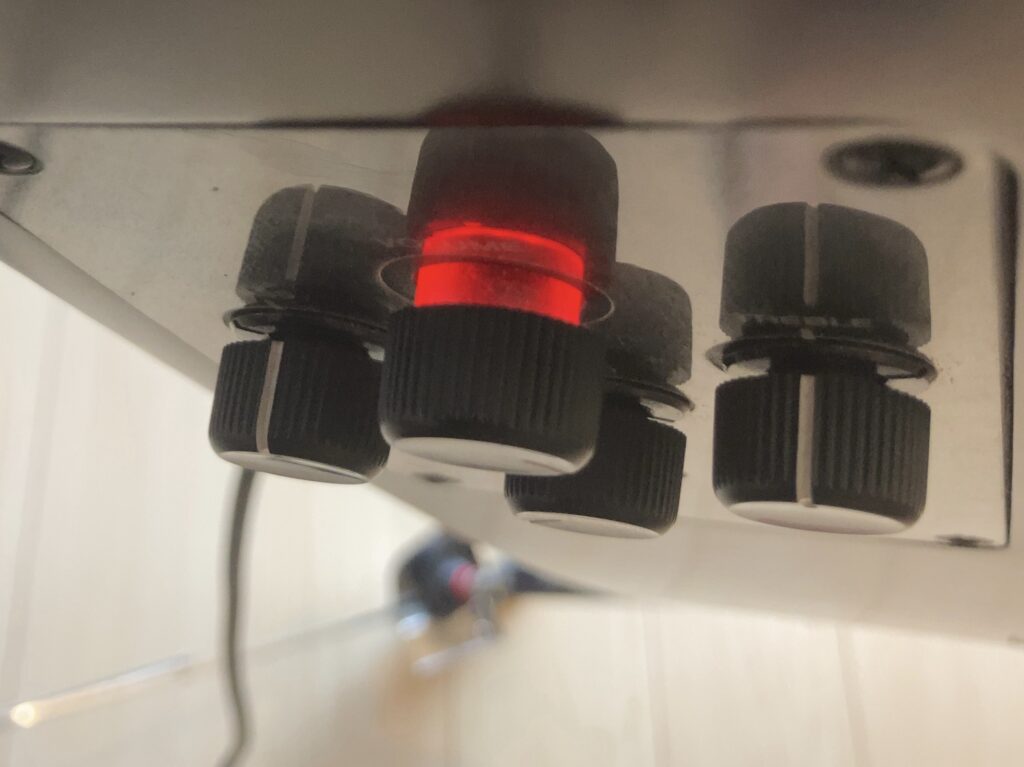
◯Points of concern and improvements
As I mentioned in the tone section, the SLB300 can be categorized as a larger-scale fretless bass, a close approximation of the double bass. One of the reasons for this is the difference in the sense of physical contact. When playing the double bass standing up, I was accustomed to raising my left heel and supporting the body with my left knee. I have a habit of standing the neck a little vertically when sliding from the high position to the low position with my left hand. At that time, I felt uncomfortable about not being able to secure the silent bass with my left knee. I don’t know if this can be solved by using the optional part for SBL300, the knee pad, which is sold separately. Since that appears to be for seated use only, I will have to check in the future if I can reach my knees in a standing position.

Addendum (11/21): On the fingerboard, there’s an area around the high A on the E string, often referred to as “No Man’s Land.” When playing pizzicato in this region, the structural design of the SLB makes it impossible to support the instrument with your foot, causing the body of the SLB to rotate and making it difficult to transfer force effectively. While this is literally a “No Man’s Land” and not a part of the fingerboard that’s played frequently, it would be ideal if there were a mechanism to securely fix the SLB’s body in place.
I am also wondering how durable the fingerboard is. Even good quality rosewood is generally not as hard as ebony, so we will observe how much the fingerboard will be worn away in the future.
The absence of a headphone jack on the SLB300 is an interesting design choice. While it might be tempting to attribute this to battery life concerns, I believe it’s more likely a deliberate decision by Yamaha to position the SLB300 as a live or recording instrument rather than a primary practice tool, especially when compared to the lower-tier models.
◯Optional parts for SLB300
-Stand
There are three types of accessories, frames, and kneepad. I currently have all but the kneepad. The stand is so convenient that I can’t imagine not having it, and I can quickly stand the SLB300 up when I need to leave the room for a while during practice. It is designed to be sturdy and shows no sign of toppling over even when I swing it sideways while it is propped up, and it seems to be able to withstand earthquakes. It also comes with a yellow strap to prevent it from tipping over, which gives additional security when I go out for an extended period of time.
-Extention frame
The extension frame can be attached to the frame part of the SBL300 using two Phillips-head screws. Officially, it did not say what this black wood is made of (probably beech). Frankly speaking, 8,000 yen is too expensive to buy one piece of unknown wood. And this extension frame changes the comfort of playing so much that I think it should be integrated into the design of SLB300 from the beginning. Without the frame, the body of the instrument lies more upright whereas with the frame, the body of the instrument is more perpendicular to the ground. The latter is easier for left hand shifting/string pressing. Also, although it is a minor detail, it would have been nice to have the same brown color as the SLB300 frame color in the color variation.
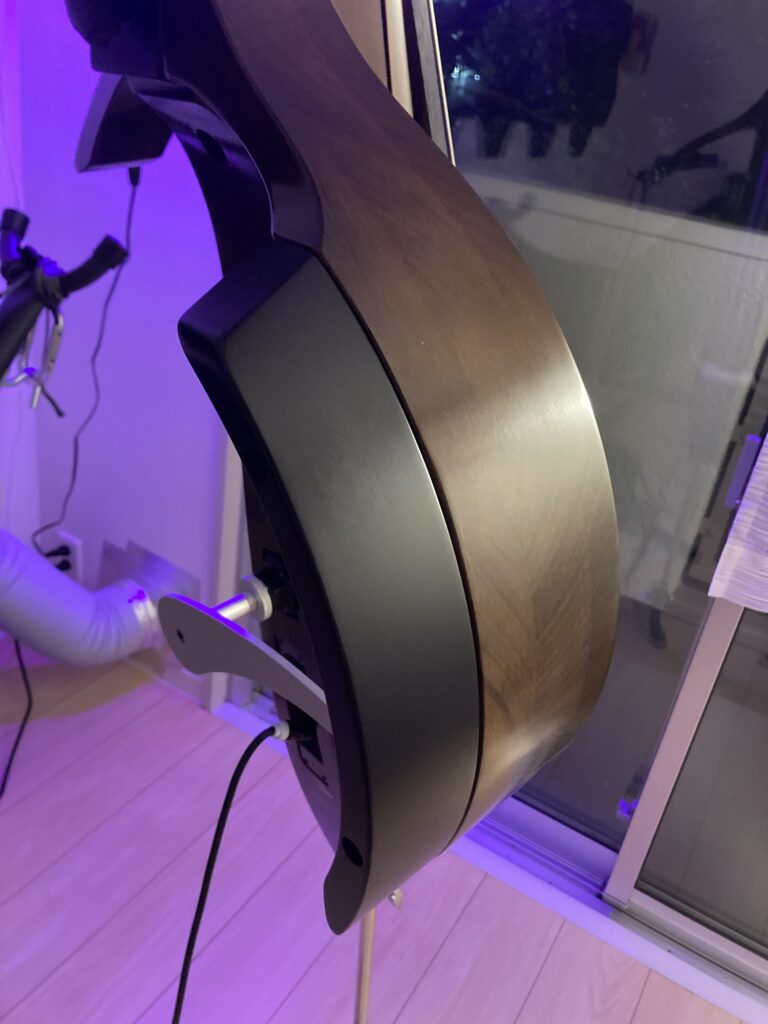
◯Storing and carrying the case
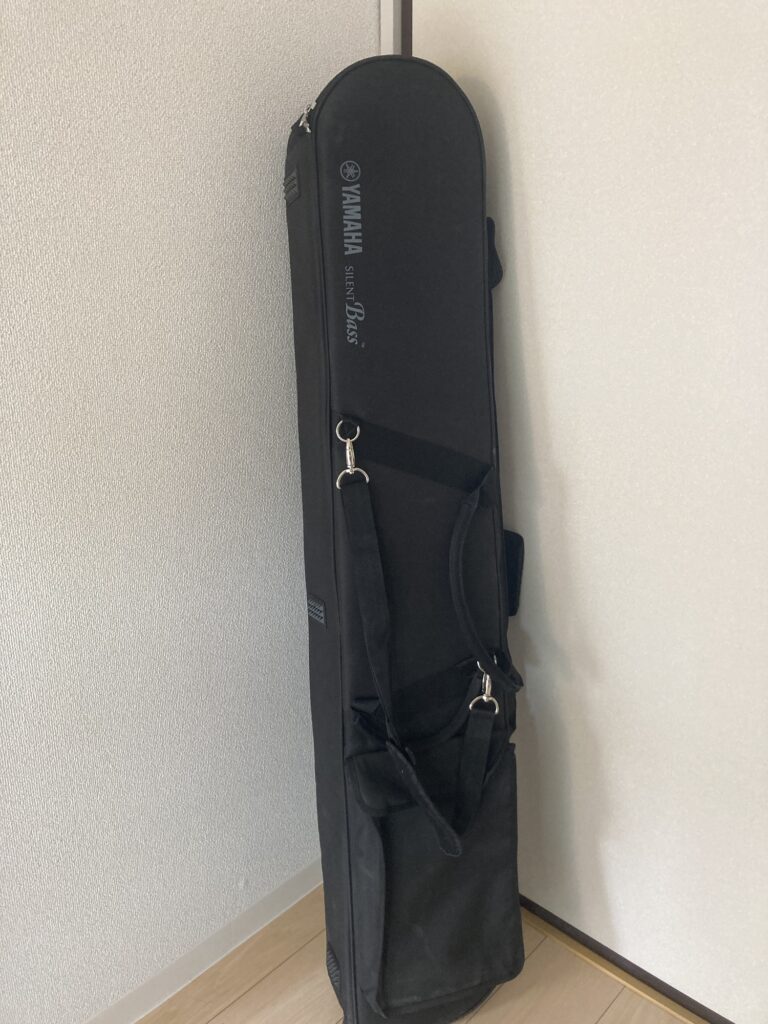
The SLB300 can be carried in the special case that comes with the instrument. It takes less than two minutes to remove the main body and frame and pack them. However, the strap that comes with the case is thin and has only one strap, so it does not fit the body well and does not distribute the load, making it feel heavy when carried. It is better to prepare another strap and carry it like a backpack. Still, the lack of volume compared to a contrabass is convenient and makes it easier to go through station gates and avoid crowds on platforms in Tokyo, lowering the threshold for train travel. Interestingly, SLB300 does not have a soul post, so even if it is subjected to external shocks during transportation, it is highly durable, giving a sense of security.
◯Others
Another advantage is that the surface area of the wood is smaller than that of a double bass, so you don’t have to worry about changes in string height due to expansion and contraction caused by changes in temperature and humidity. This is a great benefit for me, as I frequently open and close the window to change the air in the room. In terms of a practice instrument, it is easy to use because that is what is made for originally. Before I got the SLB300, I used to practice by attaching a mute to the double bass, picking up the sound from the pickups, and using headphones through an amplifier as shown below. I was practicing with headphones through an amplifier.
However, the mute reduces the sustain, so I had to practice with a sound that was not original to the instrument. Using the SLB300, I’ve become more aware of my left-hand vibrato and articulation. The clarity of the headphone sound compared to the amplified sound has helped me focus on these techniques. Also, the sustain is noticeable if the strings are not muted well by hands/fingers.
As a general comment, the SLB300 is worth considering as an option when buying a double bass with a budget in the 350,000 yen range(2,400 dollar). The quality of the instrument, the sound, and the playability are all excellent. In the same price range, hybrid veneers and Romanian carved double basses such as the Gliga are also options (in Japan), but considering portability and quietness, the SLB300 is probably the best choice.